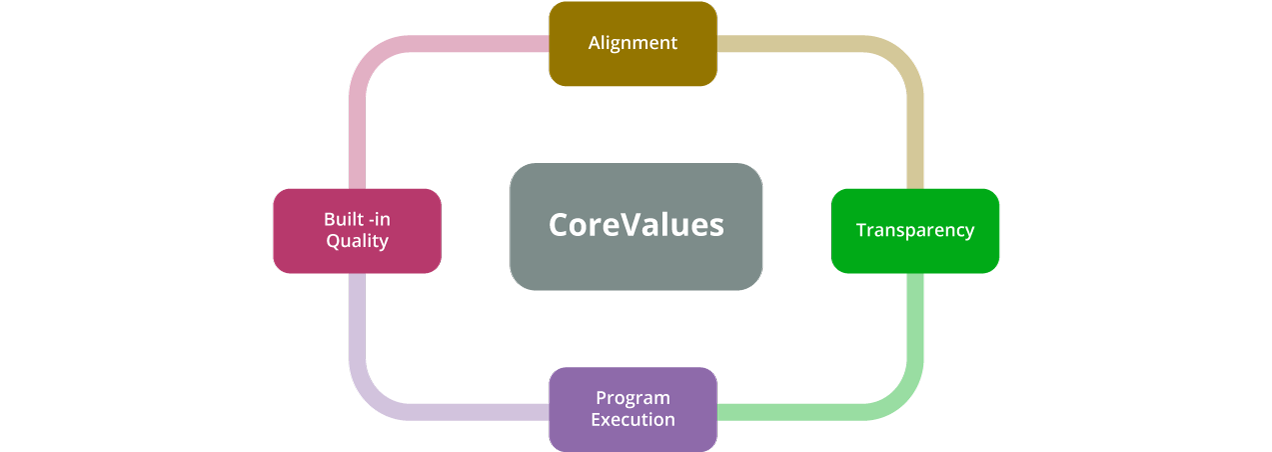What Are the 4 Core Values of Safe
The foundation of SAFe is its 4 core values and it is important to understand these before jumping into the concepts of SAFe. So, what is SAFe? SAFe is a model for scaling Agile.
Agile development is based on iterative and incremental development, in which requirements and solutions evolve through team collaboration. It recommends a time-boxed iterative approach, and encourages rapid and flexible response to change. It is a theoretical framework and does not specify any particular practice that a development team should follow.
Agile uses short iterations of 1 to 4 weeks so that the development process is aligned with the changing business needs. Instead of a single-pass development of 6 to 18 months where all the requirements and risks are predicted upfront, Agile adopts a process of frequent feedback where a workable product is delivered after 1 to 4-weeks of iteration.
SAFe is particularly well-suited for complex projects that involve multiple large teams at the project, program, and portfolio levels. It enables larger organizations to manage projects with a higher degree of agility, and helps in getting feedback faster from multiple stakeholders across the globe. This accelerated feedback loop leads to higher engagement levels, increased productivity and improved work quality.
Core Values of SAFe® Model:- SAFe has defined 4 core values as part of their framework, which are as follows:
This also helps in continuous delivery pipeline, which means releasing the product much faster and providing the ability to release on demand.
The four Core Values of alignment, built-in quality, transparency, and program execution represent the fundamental key beliefs of SAFe effectiveness. SAFe provides guiding principles and helps in directive behaviour and action for everyone who participates in SAFe. Successful teams and programs who implemented SAFe had aligned their organizations along these core values and gained many benefits including employee engagement, productivity, quality, and time to market.
SAFe Core Values are responsible for ordering the behaviour and action of an organization working in a SAFe portfolio. Determining core values of an organization is an essential part of its success. Adhering to these values makes the path to accomplishing your business objectives consistent and creates a unified thriving culture.
SAFe is essential for Agile Teams and it should be incorporated to help achieve our business goals as it encourages quick adaptability to changes in technology and economic conditions. SAFe promotes collaboration and transparency between the development and the top management with an active interaction between the development team from top to bottom and ensures we attain business value within sustainable time.
Regardless of the size of the enterprise, SAFe allows scalability and configurability that suits our business needs, and helps in focusing on delivering working software after every two weeks. Agile Release Train (ART) brings together multiple agile teams on a consistent routine every 8-12 weeks in what is known as a Program Increment (PI). Planning cadence based sessions where agile teams come together to define the goals they wish to achieve is next fixed and time bound. PI planning is a face to face, collaborative, interactive and innovative session that builds team spirit and synergy and promotes the sharing of strategy, common vision and architecture amongst development and the managerial teams.
Continuous integration and validation among the teams and constant feedback from customers helps maintain a successful business relationship leaving room for improvement throughout the entire process; which in turn provides significant improvement in business productivity, quality, employee engagement and time to market.
SAFe Core Values are responsible for ordering the behaviour and action of an organization working in a SAFe portfolio. Determining core values of an organization is an essential part of its success. SAFe is an industry-proven, value-focused method for scaling Agile at the Enterprise level. SAFe helps teams in large organizations to meet the organization’s strategic goals, not just individual project goals.
The framework offers the ability to maintain and create a centralized strategy to deliver value. The SAFe model has four levels that centralize the strategic themes of an organization. Centralized strategy is combined with the decentralized agile development execution. Adhering to these values makes the path to accomplishing your business objectives consistent and creates a unified thriving culture for all participants.
- Unit Testing, where developers write test cases by breaking the code into several smaller parts and execute those parts as automated test cases, which in turn help the developer write the code in an effective manner and provide better built-in quality deliverables.
- Pair Programming, where 2 developers work on the same station and on the same user story. One will write the code and the other will be the reviewer providing real time feedback. This helps the developers to think about the problems in a broader perspective, even including some unknown edge cases which may come in. This helps in effective built-in quality deliverables.
- Coding Standards – Collective ownership should be there with the team for the work that is being delivered. This will reduce the inter dependencies within the team and help individuals add functionality, fix any errors, refactor the code and improve the design. Always following the standard coding standards helps in consistent deliverables.
Research & References of What Are the 4 Core Values of Safe|A&C Accounting And Tax Services
Source
